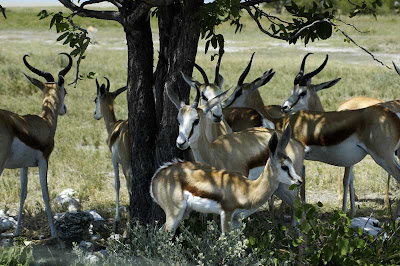
Recite "ker-bek-ker-bek-ker-bek-krrrrr..." repeatedly and you'll likely attract flocks of the Helmeted Guineafowl (Numida meleagris).
The above is one of my all time favourite wildlife pix.
Described as "very common" in sub-Saharan Africa by Newman's Birds of Southern Africa, I love these birds. Their plummage is so psychodelic. Just gaze at their bodies. It's mesmerizing. Their heads are crazy, futuristic looking.
And, unlike most birds that are tiny, I can get a decent image of them with my measly Nikon 75-300 mm (1.5X crop factor) zoom lens.
Helmeted Guineafowl Factoids of the Day...
Tastes like chicken... just kidding...
Bigger than a bucket of KFC, but smaller than a turkey...
Extremely gregarious when not breeding. Flocks are composed of up to 25 birds...
Monday, June 29, 2009
Who let the birds out? Part One... The Helmeted Guineafowl (Numida meleagris), Etosha National Park, Namibia
Friday, June 26, 2009
Who's scared of the big bad lion (Panthera leo)? Me!! - Etosha National Park, Namibia

My, Mr. Lion, what big eyes you have...and that sweet, sweet breath... Look for the reflection of a little iddy biddy, trembling Chinese dude in his eyes.
My safari mate and good friend Ahmed has this knack of getting us really close to wildlife. On this occasion, he drove right up close to a small group (3 or 4) of bachelor lions.
How close? I, in the passenger front seat, was less than 2 metres from the closest lion, with the window wide open. I could see the reflection of the car in the big cat's eyes.
For the first time, I actually had to zoom out with the camera lens to take photos in Etosha.
Suffice to say, I suggested to Ahmed to keep the car running and his foot on top of the throttle just in case.
Crazy thing about the situation is that the second you stick an appendage out the car door or window, you are toast my friends, lion snack, tender vittles, etc.
Mantra of the moment, "stay in the car, stay in the car..."
My, Mr. Lion, what great big teeth you have...
My life as a lion (Panthera leo leo)... C'mon lion, go out and kill something for the tourists. Maybe let out a bit of a roar...or, at least yawn.
Factoid of the day...
According to my Road Map of the Etosha National Park (1994), the lion population was estimated at 300.
Monday, June 22, 2009
Gnu Kid On The Savannah (GKOTS) - Etosha National Park, Namibia

Connochaetes taurinus aka the Gnu (pronounced "G-new" or just "new"), aka the Blue Wildebeest (for the bluish/grey sheen of it's hide), aka the Brindled Gnu. Thank God for scientific names.
Often described as an "ungainly" ungulate, wildebeests grow to 1.7m at the shoulder, and weigh up to 380kg.
The front-heavy wildebeest reminds me of the Orcs in the Tolkien's Lord of the Rings. They look rather clumsy but are in fact quite agile on their hooves. Healthy adults are renown for taking on and beating the crap out of predators such as lions. On the other hand, in terms of observation and photography, these were amongst the most skittish creatures around.
Tuesday, June 16, 2009
Definitely Not An Adidas Running Shoe - Springbok (Gazelle), Etosha, Namibia...

There's one in every crowd... At least someone's paying attention to the nutty photogs...
Daytime temperatures while we were in Etosha rose into the upper thirties. Crazy tourists sat in their hot furnace-like vehicles while the wiser Springboks (Antidorcas marsupialis) took refuge from the blazing sun under the shade of leafy green trees.
Springbok (Afrikaans) = Spring (jump) + bok (antelope)
Springboks can jump to a height of 3.5 m.
To communicate the presence of predators, springboks will pronk or serially jump into the air while running.
The South African National Rugby Team is nicknamed the Springboks.
Source: Wikipedia.
Monday, June 15, 2009
Definitely not a Chevrolet - The Black Faced Impala, Etosha National Park, Namibia...

This no bambi. It's Aepyceros melampus petersi (common names: Black-Faced Impala (English) or Rooibok (Afrikaans))!
This sub-species seems to be endemic to Namibia. The Black-faced Impala is listed as vulnerable to extinction. According to the ICUN listing, there are approximately 1000 animals left in Namibia.
Gotta keep up fighting skills for rutting season... Described as the quintessential African antelope, males grow to 55-75 kg while female weigh in at 35-53 kg.
Being gregarious animals, impalas tend to group together in large herds. When resources like food are plentiful, male impalas become territorial, taking possession of females that wander into their respective territories and kicking out bachelor males. A male impala may have a "harem" of up to 100 females in some cases.
Little known impala factoids:
Impala appear as appetizers in the menus of cheetah and leopards.
Adults can leap 12 m and 3 m in height in a single bound!
Sunday, June 07, 2009
Sunday Driving - Etosha National Park, Namibia
Be prepared to share the road while driving in Etosha.
Very wide load... (Loxodonta africana)
Very narrow load...(Giraffa camelopardalis giraffa).
Etosha Factoids of the day.
Etosha National Park was established by German occupiers in 1907. Originally the size of the park was 100,000 sq. km. Due to "political pressure", the park was reduced to its current size of 22,270 sq. km.
"The Park is home to 114 mammal species, 340 bird species, 110 reptile species, 16 amphibian species and, surprisingly, one species of fish".
I must report no sightings of fish in the park.


